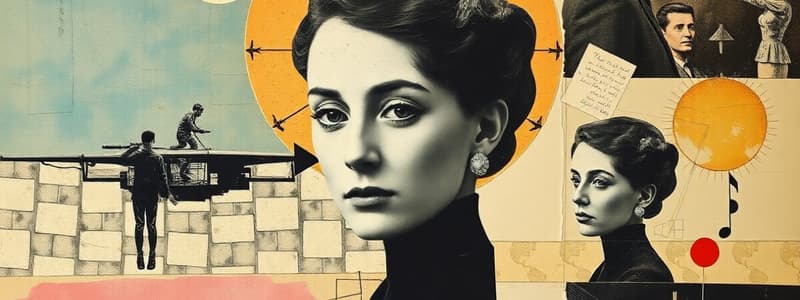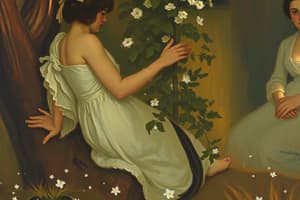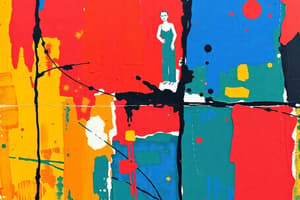Podcast
Questions and Answers
What is one primary reason artists create art?
What is one primary reason artists create art?
- To attain financial success
- To fulfill societal expectations
- To follow trends and be popular
- For personal expression and to connect with others (correct)
Which of the following illustrates the misconception about artists' work styles?
Which of the following illustrates the misconception about artists' work styles?
- Artists are often spontaneous and laid back (correct)
- Artists generally avoid technical skills
- Artists have specific disciplines they adhere to
- Artists follow structured procedures in their work
What attitude should one develop towards artists with disabilities?
What attitude should one develop towards artists with disabilities?
- Skepticism regarding their abilities
- Apathy towards their work
- Belief that they require special treatment
- Inclusivity and understanding (correct)
What relationship between art and science is suggested by Einstein's quote?
What relationship between art and science is suggested by Einstein's quote?
What is implied about the common notions of artists in the content?
What is implied about the common notions of artists in the content?
What are the key components involved in the conception of a tangible art form?
What are the key components involved in the conception of a tangible art form?
What aspect of art does 'What' refer to in the diagram?
What aspect of art does 'What' refer to in the diagram?
How is the process of creating art organized in the discussed framework?
How is the process of creating art organized in the discussed framework?
What important theme is highlighted in the analysis questions about Chuck Close?
What important theme is highlighted in the analysis questions about Chuck Close?
What can be inferred about Chuck Close based on the provided content?
What can be inferred about Chuck Close based on the provided content?
Which of the following best represents the significance of the 'Why' in the art creation process?
Which of the following best represents the significance of the 'Why' in the art creation process?
What does the activity regarding Chuck Close focus on assessing?
What does the activity regarding Chuck Close focus on assessing?
Which conclusion can be drawn from the content about the challenges artists may face?
Which conclusion can be drawn from the content about the challenges artists may face?
What is a key distinction between an artist and an artisan regarding their approach to their work?
What is a key distinction between an artist and an artisan regarding their approach to their work?
According to the provided information, how is an artist's technique perceived?
According to the provided information, how is an artist's technique perceived?
How does Hegel characterize an artist’s activity?
How does Hegel characterize an artist’s activity?
In what way do artists and artisans learn from each other?
In what way do artists and artisans learn from each other?
What best describes the role of an artisan in their work compared to an artist?
What best describes the role of an artisan in their work compared to an artist?
What is a shared aspect between artists and artisans despite their differences?
What is a shared aspect between artists and artisans despite their differences?
What opinion is reflected about rivalry in the art scene?
What opinion is reflected about rivalry in the art scene?
Which of the following statements correctly reflects an artisan's process?
Which of the following statements correctly reflects an artisan's process?
What is the primary aim of art historians?
What is the primary aim of art historians?
How do art critics contribute to the understanding of art?
How do art critics contribute to the understanding of art?
What does the purchasing behavior of individuals reflect?
What does the purchasing behavior of individuals reflect?
What often leads people to undervalue art according to common tendencies?
What often leads people to undervalue art according to common tendencies?
Why might individuals struggle with the idea of purchasing art?
Why might individuals struggle with the idea of purchasing art?
In considering the value of art, what do individual's purchasing choices often signify about them?
In considering the value of art, what do individual's purchasing choices often signify about them?
What is a common misconception about spending money on art?
What is a common misconception about spending money on art?
Which of the following statements best reflects the relationship between consumer choices and personal value systems?
Which of the following statements best reflects the relationship between consumer choices and personal value systems?
What can envy lead to in the context of artistic development?
What can envy lead to in the context of artistic development?
What does the adage ‘good artists copy, great artists steal’ suggest about artistic influence?
What does the adage ‘good artists copy, great artists steal’ suggest about artistic influence?
What challenges do artists, particularly in third world countries, often face?
What challenges do artists, particularly in third world countries, often face?
How should society view artists with different educational backgrounds?
How should society view artists with different educational backgrounds?
What is one key factor that can contribute to psychological and physical stress for artists?
What is one key factor that can contribute to psychological and physical stress for artists?
What is suggested about the contributions of various artistic processes?
What is suggested about the contributions of various artistic processes?
In discussing the art world, which individuals are primarily involved?
In discussing the art world, which individuals are primarily involved?
What is an effect of daily struggles faced by artists?
What is an effect of daily struggles faced by artists?
Flashcards are hidden until you start studying
Study Notes
Artistic Process
- Artists are not always spontaneous, they employ procedures and disciplines in their work
- Art encompasses various subjects including science, philosophy, and practical living
- Art can be applied to areas of knowledge and can demonstrate scientific, philosophical, or practical knowledge
- Art involves what, how, and why
- What: The subject matter, the content of the work, the underlying significance
- How: The techniques and materials involved, the process involved
- Why: The narrative behind the subject matter, the concept, the meaning
Production Process
- Artists have stages in their production process
- Artists take steps to create art
- The steps include collecting materials, sketching, and refining their ideas
- Artists begin with an idea and explore different ways to manifest them
- Artists continuously refine their work and practice to produce a final piece
Inclusivity Of Artists
- Artists face challenges in the art world
- The art world is not always about having a dream job; Often, it is a daily struggle between survival and passion
- Artists often need side jobs to survive
- The pressures of life and art-making can lead to psychological and physical stress
- Artists with disabilities or mental incapacities challenge the notion of what an artist is
- The limitations and challenges of artists can be seen as opportunities for personal growth and artistic innovation
Artists and Artisans
- Artists possess technical ability and inject creativity into their work
- Artisans also possess technical ability but they follow the dictates of a designer
- Artists are more involved in exploration and discovery
- Artisans are more focused on manipulation of materials to achieve a pre-determined result
- In art, technique is a means to an end for artists, whereas it is an end in itself for artisans
Rivalry, Envy, and Artistic Preference
- Artists often compete and compare their work to each other
- Such rivalry can serve as fuel for innovation
- Envy can be a discouraging force for artists.
- Envy, however, can also be a positive force as it can drive artists to improve their work.
The Art World
- The art world is comprised of a number of individuals and groups:
- Artists: Individuals who create artwork
- Patrons: Individuals or groups who support art financially
- Collectors: Individuals who buy and store art
- Art Dealers: Individuals or groups who sell art
- Galleries and Museums: Places that exhibit art
- Art Writers (historians and critics): Individuals who analyze and interpret art
- Art Educators: Individuals who teach about art:
Valuing Artists Through Money
- The value of art is often equated with money, which may not be a fair indicator of its true value
- The decision to buy art can be influenced by taste, perceived value, and social/cultural factors
- The act of buying art reflects what we value, similarly we value our health by making choices about what to consume
Studying That Suits You
Use AI to generate personalized quizzes and flashcards to suit your learning preferences.





